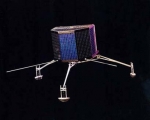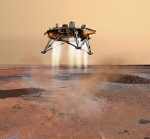Displaying items by tag: lander
Philae lander
Philae is a robotic European Space Agency lander that accompanies its Rosetta spacecraft. It is designed to land on Comet 67P/Churyumov-Gerasimenko shortly after arrival in 2014. The lander is named after Philae island in the Nile, where an obelisk was found that was used along with the Rosetta Stone to decipher Egyptian hieroglyphic.
Just as the Philae(*) Obelisk and the Rosetta Stone provided the keys to an ancient civilisation, the Philae lander and the Rosetta orbiter aim to unlock the mysteries of the oldest building blocks of our Solar System - comets.
(*) Philae is the island in the river Nile on which an obelisk was found that had a bilingual inscription including the names of Cleopatra and Ptolemy in Egyptian hieroglyphs. This provided the French historian Jean-François Champollion with the final clues that enabled him to decipher the hieroglyphs of the Rosetta Stone and unlock the secrets of the civilisation of ancient Egypt.
Mighty Eagle (lander)
The Mighty Eagle is a Prototype Robotic Lander developed by NASA at the Marshall Space Flight Center in Huntsville, Alabama.
The vehicle is an autonomous flying testbed that is used for testing hardware, sensors and algorithms. These sensors and algorithms include such things as onboard cameras that, with specialized guidance, navigation and control software, could aid in the capture of orbiting space debris, in-space docking with a fuel depot, docking of a robotic lander with an orbiting command module and the rendezvous of multiple unmanned stages for deep space human exploration of the solar system.
Morpheus Lander
Morpheus Lander is a NASA project to develop a vertical take off and landing test bed vehicle.
The NASA designed robotic lander can land 500 kg of cargo on the Moon. It was manufactured and assembled at NASA's Johnson Space Center (JSC) and Armadillo Aerospace's facility near Dallas, USA. The prototype lander is a "spacecraft" that is about 3.0 m in diameter, weighs approximately 1,000 kg and consists of four silver spherical propellant tanks topped by avionics boxes and a web of wires.
Phoenix (spacecraft)
Phoenix was a robotic spacecraft on a space exploration mission on Mars under the Mars Scout Program.
The Phoenix lander descended on Mars on May 25, 2008. Mission scientists used instruments aboard the lander to search for environments suitable for microbial life on Mars, and to research the history of water there.
The multi-agency program was headed by the Lunar and Planetary Laboratory at the University of Arizona, under the direction of NASA's Jet Propulsion Laboratory. The program was a partnership of universities in the United States, Canada, Switzerland, Denmark, Germany, the United Kingdom, NASA, the Canadian Space Agency, the Finnish Meteorological Institute, Lockheed Martin Space Systems, MacDonald Dettwiler & Associates (MDA) and other aerospace companies. It was the first mission to Mars led by a public university in NASA history. The mission underscored the value of university-led management. It was led directly from the University of Arizona's campus in Tucson, with project management at the Jet Propulsion Laboratory in Pasadena, Calif., and project development at Lockheed Martin in Denver, Colorado. The operational funding for the mission extended through November 10, 2008.
Phoenix is NASA's sixth successful landing out of seven attempts and is the most recent spacecraft to land successfully on Mars as well as the first successful landing in a Martian polar region. The lander completed its mission in August 2008, and made a last brief communication with Earth on November 2 as available solar power dropped with the Martian winter. The mission was declared concluded on November 10, 2008, after engineers were unable to re-contact the craft. After unsuccessful attempts to contact the lander by the Mars Odyssey orbiter up to and past the Martian summer solstice on May 12, 2010, JPL declared the lander to be dead. Like the two Mars Exploration Rovers, the program was considered a success because it completed all planned science experiments and observations.




